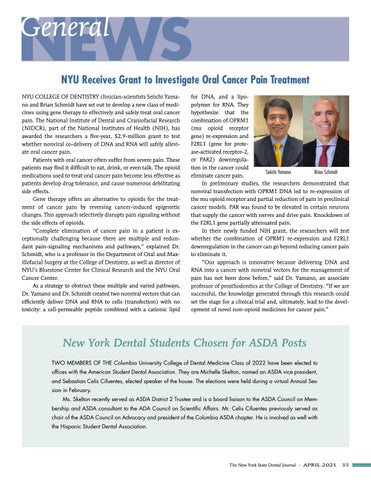NEWS General
NYU Receives Grant to Investigate Oral Cancer Pain Treatment
NYU COLLEGE OF DENTISTRY clinician-scientists Seiichi Yamano and Brian Schmidt have set out to develop a new class of medicines using gene therapy to effectively and safely treat oral cancer pain. The National Institute of Dental and Craniofacial Research (NIDCR), part of the National Institutes of Health (NIH), has awarded the researchers a five-year, $2.9-million grant to test whether nonviral co-delivery of DNA and RNA will safely alleviate oral cancer pain. Patients with oral cancer often suffer from severe pain. These patients may find it difficult to eat, drink, or even talk. The opioid medications used to treat oral cancer pain become less effective as patients develop drug tolerance, and cause numerous debilitating side effects. Gene therapy offers an alternative to opioids for the treatment of cancer pain by reversing cancer-induced epigenetic changes. This approach selectively disrupts pain signaling without the side effects of opioids. “Complete elimination of cancer pain in a patient is exceptionally challenging because there are multiple and redundant pain-signaling mechanisms and pathways,” explained Dr. Schmidt, who is a professor in the Department of Oral and Maxillofacial Surgery at the College of Dentistry, as well as director of NYU’s Bluestone Center for Clinical Research and the NYU Oral Cancer Center. As a strategy to obstruct these multiple and varied pathways, Dr. Yamano and Dr. Schmidt created two nonviral vectors that can efficiently deliver DNA and RNA to cells (transfection) with no toxicity: a cell-permeable peptide combined with a cationic lipid
for DNA, and a lipopolymer for RNA. They hypothesize that the combination of OPRM1 (mu opioid receptor gene) re-expression and F2RL1 (gene for protease-activated receptor-2, or PAR2) downregulation in the cancer could Seiichi Yamano Brian Schmidt eliminate cancer pain. In preliminary studies, the researchers demonstrated that nonviral transfection with OPRM1 DNA led to re-expression of the mu opioid receptor and partial reduction of pain in preclinical cancer models. PAR was found to be elevated in certain neurons that supply the cancer with nerves and drive pain. Knockdown of the F2RL1 gene partially attenuated pain. In their newly funded NIH grant, the researchers will test whether the combination of OPRM1 re-expression and F2RL1 downregulation in the cancer can go beyond reducing cancer pain to eliminate it. “Our approach is innovative because delivering DNA and RNA into a cancer with nonviral vectors for the management of pain has not been done before,” said Dr. Yamano, an associate professor of prosthodontics at the College of Dentistry. “If we are successful, the knowledge generated through this research could set the stage for a clinical trial and, ultimately, lead to the development of novel non-opioid medicines for cancer pain.”
New York Dental Students Chosen for ASDA Posts TWO MEMBERS OF THE Columbia University College of Dental Medicine Class of 2022 have been elected to offices with the American Student Dental Association. They are Michelle Skelton, named an ASDA vice president, and Sebastian Celis Cifuentes, elected speaker of the house. The elections were held during a virtual Annual Session in February. Ms. Skelton recently served as ASDA District 2 Trustee and is a board liaison to the ASDA Council on Membership and ASDA consultant to the ADA Council on Scientific Affairs. Mr. Celis Cifuentes previously served as chair of the ASDA Council on Advocacy and president of the Columbia ASDA chapter. He is involved as well with the Hispanic Student Dental Association.
The New York State Dental Journal APRIL 2021 35 ●




